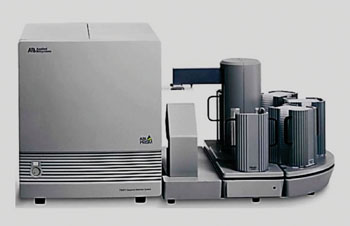Increased Baseline C-Reactive Protein Linked to Heightened Infection Risk
By LabMedica International staff writers
Posted on 01 Feb 2016
C-reactive protein (CRP) is an innate immune system recognition and effector molecule that plays a role in both the innate response and as an adaptor to the complex immune system. Posted on 01 Feb 2016
In an infectious disease or inflammatory state, rapid CRP upregulation occurs and the most pronounced increases are primarily seen in infectious diseases and the acute-phase CRP increases rapidly during an infection.

Image: The ABI PRISM 7900HT Sequence Detection System (Photo courtesy of the University of Geneva).
Clinical biochemists at the Copenhagen University Hospital (Denmark) studied 9,660 individuals from a prospective general population cohort, including 3,592 in whom infectious disease developed, and another 60,896 individuals from a cross-sectional general population study, of whom 13,332 developed infectious disease; 55% were women, and the mean age was 57 years. Infectious diseases were classified as bacterial, viral, or other.
The ABI Prism 7900HT SDS (Applied Biosystems; Foster City, CA, USA) was used to genotype for four single nucleotide polymorphisms in the CRP gene (rs3091244, rs1130864, rs1205, and rs3093077). Genotyping was verified by DNA sequencing in more than 30 individuals with each genotype. CRP was measured with high-sensitivity nephelometry or turbidimetry assays. Covariates for adjustments were chosen on the basis of known influence on plasma CRP concentrations or risk of infection.
The teams found that individuals with CRP greater than 3 mg/L had 1.2 and 1.7 times increased risk of infectious disease, in the prospective general population cohort and the cross-sectional general population study, respectively, compared with individuals with CRP of less than 1 mg/L. In the combined populations, individuals in the highest CRP tertile compared with the lowest had an increased risk of bacterial diseases, but not viral, mycosis, and parasitic diseases. The increased risk was mainly carried by pneumonia, sepsis, and particularly gram-negative infections. None of the genotype combinations examined conferred an increased risk of infectious disease.
The authors concluded that chronic low-level increased plasma CRP concentrations to be associated with an increased risk of bacterial infections, and in particular gram-negative infections. However, genotypes associated with increases in plasma CRP concentrations were not associated with increased risk of infection. The study was published on December 31, 2015, in the journal Clinical Chemistry.
Related Links:
Copenhagen University Hospital
Applied Biosystems













